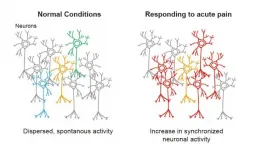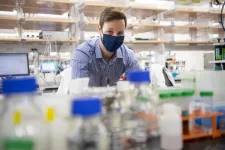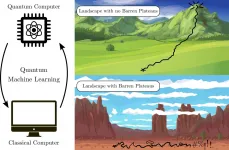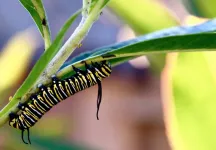Tiny machine poised to unlock brain's mysteries
Novel device records, senses and manipulates 'mini-brains'
2021-03-19
(Press-News.org) A team of scientists, led by researchers at Northwestern University, Shirley Ryan AbilityLab and the University of Illinois at Chicago (UIC), has developed novel technology promising to increase understanding of how brains develop, and offer answers on repairing brains in the wake of neurotrauma and neurodegenerative diseases.
Their research is the first to combine the most sophisticated 3-D bioelectronic systems with highly advanced 3-D human neural cultures. The goal is to enable precise studies of how human brain circuits develop and repair themselves in vitro. The study is the cover story for the March 19 issue of Science Advances.
The cortical spheroids used in the study, akin to "mini-brains," were derived from human-induced pluripotent stem cells. Leveraging a 3-D neural interface system that the team developed, scientists were able to create a "mini laboratory in a dish" specifically tailored to study the mini-brains and collect different types of data simultaneously. Scientists incorporated electrodes to record electrical activity. They added tiny heating elements to either keep the brain cultures warm or, in some cases, intentionally overheated the cultures to stress them. They also incorporated tiny probes -- such as oxygen sensors and small LED lights -- to perform optogenetic experiments. For instance, they introduced genes into the cells that allowed them to control the neural activity using different-colored light pulses.
This platform then enabled scientists to perform complex studies of human tissue without directly involving humans or performing invasive testing. In theory, any person could donate a limited number of their cells (e.g., blood sample, skin biopsy). Scientists can then reprogram these cells to produce a tiny brain spheroid that shares the person's genetic identity. The authors believe that, by combining this technology with a personalized medicine approach using human stem cell-derived brain cultures, they will be able to glean insights faster and generate better, novel interventions.
"The advances spurred by this research will offer a new frontier in the way we study and understand the brain," said Shirley Ryan AbilityLab's Dr. Colin Franz, co-lead author on the paper who led the testing of the cortical spheroids. "Now that the 3-D platform has been developed and validated, we will be able to perform more targeted studies on our patients recovering from neurological injury or battling a neurodegenerative disease."
Yoonseok Park, postdoctoral fellow at Northwestern University and co-lead author, added, "This is just the beginning of an entirely new class of miniaturized, 3-D bioelectronic systems that we can construct to expand the capacity of the regenerative medicine field. For example, our next generation of device will support the formation of even more complex neural circuits from brain to muscle, and increasingly dynamic tissues like a beating heart."
Current electrode arrays for tissue cultures are 2-D, flat and unable to match the complex structural designs found throughout nature, such as those found in the human brain. Moreover, even when a system is 3-D, it is extremely challenging to incorporate more than one type of material into a small 3-D structure. With this advance, however, an entire class of 3-D bioelectronics devices has been tailored for the field of regenerative medicine.
"Now, with our small, soft 3-D electronics, the capacity to build devices that mimic the complex biological shapes found in the human body is finally possible, providing a much more holistic understanding of a culture," said Northwestern's John Rogers, who led the technology development using technology similar to that found in phones and computers. "We no longer have to compromise function to achieve the optimal form for interfacing with our biology."
As a next step, scientists will use the devices to better understand neurological disease, test drugs and therapies that have clinical potential, and compare different patient-derived cell models. This understanding will then enable a better grasp of individual differences that may account for the wide variation of outcomes seen in neurological rehabilitation.
"As scientists, our goal is to make laboratory research as clinically relevant as possible," said Kristen Cotton, research assistant in Dr. Franz's lab. "This 3-D platform opens the door to new experiments, discovery and scientific advances in regenerative neurorehabilitation medicine that have never been possible."
INFORMATION:
The work was supported by a National Institutes of Health Research Project Grant (R01) shared by Northwestern's John Rogers and Yonggang Huang, the Shirley Ryan AbilityLab's Dr. Colin Franz and UIC's John Finan. It also was supported by a generous philanthropic gift from the family of Belle Carnell, which established a regenerative neurorehabilitation fund for precision medicine in Dr. Franz's lab.
[Attachments] See images for this press release:
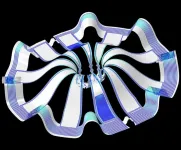
ELSE PRESS RELEASES FROM THIS DATE:
2021-03-19
In a world first, a cross-institutional research collaboration has used a two-photon microscope (*1) with a combination of calcium imaging (*2) and holographic stimulation (*3) to reveal that the functional connectivity between neurons located in the primary somatosensory cortex is increased in response to acute pain.
Pain occurs as a result of injury, such as peripheral neuron damage or inflammation stemming from peripheral tissue violation. Research findings have been published on the involvement of central nervous system abnormalities in the onset of pain and sustained pain. The primary somatosensory cortex ...
2021-03-19
COLUMBUS, Ohio - Most stroke victims don't receive treatment fast enough to prevent brain damage. Scientists at The Ohio State University Wexner Medical Center, College of Engineering and College of Medicine have developed technology to "retrain" cells to help repair damaged brain tissue. It's an advancement that may someday help patients regain speech, cognition and motor function, even when administered days after an ischemic stroke.
Engineering and medical researchers use a process created by Ohio State called tissue nanotransfection (TNT) to introduce genetic material into cells. This allows them to reprogram skin cells to become something ...
2021-03-19
New York, NY--March 19, 2020--Columbia Engineering researchers, working with Brookhaven National Laboratory, report today that they have built designed nanoparticle-based 3D materials that can withstand a vacuum, high temperatures, high pressure, and high radiation. This new fabrication process results in robust and fully engineered nanoscale frameworks that not only can accommodate a variety of functional nanoparticle types but also can be quickly processed with conventional nanofabrication methods.
"These self-assembled nanoparticles-based materials are so resilient that they could fly in space," says Oleg Gang, professor ...
2021-03-19
PITTSBURGH, March 19, 2021 - Non-circulating memory T cells, whose main function is to provide local protection against re-infection, contribute to chronic transplant rejection, University of Pittsburgh School of Medicine researchers reveal in a paper published today in Science Immunology.
The scientists show that these "tissue-resident memory T cells" are harmful in situations where antigens that the cells recognize are present in the body for a long time, such as in cases of an organ or tissue transplant. This finding is an important step toward improving therapies to help prevent organ rejection in transplant recipients.
"Tissue-resident memory T cells serve an important surveillance function," said co-senior author Martin Oberbarnscheidt, ...
2021-03-19
CAMBRIDGE, MA -- Many viruses infect their hosts through mucosal surfaces such as the lining of the respiratory tract. MIT researchers have now developed a vaccination strategy that can create an army of T cells that are ready and waiting at those surfaces, offering a quicker response to viral invaders.
The researchers showed that they could induce a strong memory T cell response in the lungs of mice by giving them a vaccine modified to bind to a protein naturally present in mucus. This can help ferry the vaccine across mucosal barriers, such as the lining of the lungs.
"In this paper, we specifically focused on T cell responses that would be useful against viruses or cancer, and our idea was to use this protein, albumin, as sort of a Trojan horse to ...
2021-03-19
To understand the fundamental properties of an industrial solvent, chemists with the University of Cincinnati turned to a supercomputer.
UC chemistry professor and department head Thomas Beck and UC graduate student Andrew Eisenhart ran quantum simulations to understand glycerol carbonate, a compound used in biodiesel and as a common solvent.
They found that the simulation provided detail about hydrogen bonding in determining the structural and dynamic properties of the liquid that was missing from classical models. The study was published in the Journal of Physical Chemistry B.
Glycerol carbonate could be a more environmentally ...
2021-03-19
During a public health crisis like the COVID-19 pandemic, U.S. hospitals need to allocate scarce medical resources in an equitable manner, according to clinicians and ethicists at the University of Miami Miller School of Medicine.
"Significant concerns have been raised that crisis standards of care may be biased against certain patients based on race or ethnicity," said Hayley Gershengorn, M.D., associate professor of pulmonary and critical care medicine. "To examine that issue, we analyzed over a thousand medical records from two academic hospitals where University of Miami faculty see patients and found no disparities ...
2021-03-19
In-school COVID-19 transmission is rare - even among close school contacts of those who test positive for the virus - when schools heed public health precautions such as mandatory masking, social distancing and frequent hand-washing, according to results of a pilot study in Missouri aimed at identifying ways to keep elementary and secondary schools open and safe during the pandemic. A close contact is anyone who has been within 6 feet for more than 15 minutes in a 24-hour period with someone infected with COVID-19.
The study is part of a larger, ongoing collaboration involving the Centers for Disease Control and Prevention (CDC), Washington University School of Medicine in St. Louis, ...
2021-03-19
LOS ALAMOS, N.M., March 19, 2021--Many machine learning algorithms on quantum computers suffer from the dreaded "barren plateau" of unsolvability, where they run into dead ends on optimization problems. This challenge had been relatively unstudied--until now. Rigorous theoretical work has established theorems that guarantee whether a given machine learning algorithm will work as it scales up on larger computers.
"The work solves a key problem of useability for quantum machine learning. We rigorously proved the conditions under which certain architectures of variational quantum algorithms will or will not have barren plateaus as they are scaled up," said Marco Cerezo, lead author on the paper published in Nature Communications ...
2021-03-19
Notwithstanding last month's cold snap in Texas and Louisiana, climate change is leading to warmer winter weather throughout the southern U.S., creating a golden opportunity for many tropical plants and animals to move north, according to a new study appearing this week in the journal Global Change Biology.
Some of these species may be welcomed, such as sea turtles and the Florida manatee, which are expanding their ranges northward along the Atlantic Coast. Others, like the invasive Burmese python -- in the Florida Everglades, the largest measured 18 feet, end-to-end --maybe less so.
Equally unwelcome, and among the quickest to spread into warming areas, are ...
LAST 30 PRESS RELEASES:
[Press-News.org] Tiny machine poised to unlock brain's mysteries
Novel device records, senses and manipulates 'mini-brains'

